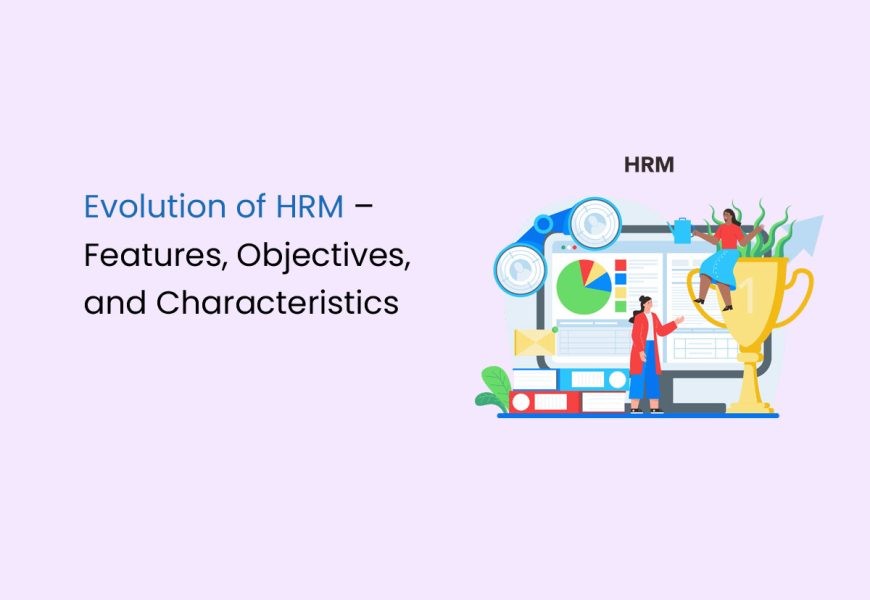Human resource management has evolved a lot over the years. Its core responsibilities have changed greatly. It is more than just a body that maintains discipline within the company and acts as a link between the higher-ups and the rest of the employees. The evolution of HRM has been steady yet quick, making it hard for most to understand how much HR is responsible for.
This evolution started in the 1980s, when the idea of a corporate office started gaining more momentum. Before the world became the way it is, trade was done by skilled craftsmen or artisans who held end-to-end responsibility for the production, generation, and sale of their goods. The mass production of resources and commercialisation of services gave rise to the need for human resources. So, let’s discuss this in greater detail in this article.
Generations of HRM
The need for Human Resource Management (HRM) has grown steadily over time as it has adapted to companies’ growing and evolving needs. These are some of the key generations of change that HRM has gone through over the years.
- Administrative HRM: The earliest form of HRM was primarily focused on administrative tasks. HR was responsible for record-keeping, managing payroll, and ensuring compliance with employment laws. This transactional approach dealt with hiring, employee benefits, and basic personnel management.
- Behavioural HRM: In the 1950s and 1960s, HR evolved to focus on the behavioural aspects of employee management. This era emphasised employee motivation, leadership development, and communication. Performance management systems, employee training programmes, and team-building initiatives became essential in this HR development phase.
- Strategic HRM: By the 1980s and 1990s, HR began to take on a more strategic role within organisations. Strategic HRM focuses on aligning human resource strategies with overall business goals. It promotes the creation of high-performance work cultures, effective talent management, and long-term workforce planning, positioning HR as a vital player in achieving organisational success.
- International HRM: With the advent of globalisation, HR evolved to include an international focus. International HRM addresses the complexities of managing a global workforce, such as dealing with diverse cultures, varying legal requirements, and developing global HR policies that balance standardisation with local adaptation.
- Digital HRM: In recent years, HRM has embraced digital technologies and analytics. Digital HRM involves using HR information systems, online recruitment tools, e-learning platforms, and data analytics to optimise HR operations. These digital advancements allow for better decision-making, improved employee experiences, and more efficient HR practices.
Impact of the Industrial Revolution on HRM
The management of workers within companies began during the Industrial Revolution in the late eighteenth century. Before this era, while many large organisations existed, the lack of advanced technology made it difficult to manage them efficiently. During this time, working conditions were far from ideal, with employees often working long hours for minimal pay in unfavourable environments.
The Evolution of Human Resource Management
In the early twentieth century, FW Taylor introduced the concept of scientific management. He proposed that there was a ‘one best way’ to perform every role in a company, aiming to improve efficiency and streamline operations. Taylor’s approach, known as job specialisation, involved breaking down tasks into specific, essential components and training employees to become experts in their roles. However, Taylor overlooked the monotony and lack of fulfilment employees might experience from performing the same tasks repetitively.
As industries grew, particularly during the Industrial Revolution, science and technology began to influence all aspects of work. This period saw significant changes in the management of human capital, including:
- Workspaces shifted from homes to centralised areas where employees performed tasks under one roof, leading to a more organised approach to labour.
- Production methods transitioned from manual labour to mechanised systems, drastically improving productivity.
- The advent of mechanisation and technological advancements, particularly with the rise of computers, revolutionised control systems within industries. Activities such as inventory management, production control, and manpower allocation became more efficient, making companies far more productive.
However, this period of change was not without its challenges. The increased reliance on machinery required a level of skilled knowledge that many workers did not possess, leading to widespread unemployment and hardship for those unable to adapt.
To sum up, the Industrial Revolution brought about both positive and negative impacts. While it fostered discipline, materialism, and economic growth through capital accumulation, it also introduced monotony, job displacement, and impersonal working environments. Business owners and entrepreneurs thrived, but the average worker often struggled to keep pace with these rapid changes.
Unionism
Soon after the rise of the factory system, many employees began to band together to address their grievances. Workers were subjected to long hours, unsafe conditions, and meagre wages. This led employees to unite and assert their value to the organisation, demanding fair treatment.
Various forms of protest were employed, including strikes, walkouts, slowdowns, boycotts, picketing, and even sabotage. On occasion, physical force was also used. These efforts proved successful, as without their workforce, businesses risked collapsing. Employers were left with no choice but to heed the demands of their employees.
In response, new organisational units were established to manage improvements in work methods, analyse wages, and place greater emphasis on addressing employee needs.
Social Responsibility
As seen earlier, employers in the past showed little regard for the welfare of their workers. However, over time, they began to recognise the value of each employee and started to accord them the respect and treatment they deserved. This shift in attitude helped create a more positive work environment, where employee satisfaction led to increased productivity.
Labour laws were reformed, most notably abolishing child labour. Workers were also provided with proper training on how to operate machinery, ensuring both their safety and efficiency. With the introduction of higher wages and better working conditions, employees became more motivated and productive, which directly contributed to the growth and success of the companies they worked for.
Human Resource Management: The Scientific Approach
The era of scientific management began around 1900 and reached its height by the 1930s. This period marked a significant transformation in how work was organised and remains influential even today. At the time, employees were burdened by manual processes, which negatively impacted their productivity and efficiency.
There was a growing need for advanced technology to relieve workers from these physical strains. Employees often worked at a slower pace, fearing that quicker output might lead to errors, which could, in turn, cost them their jobs. This hesitation resulted in wasted time and diminished productivity, as workers were frequently assigned tasks outside of their expertise or comfort zone.
This mismatch between skills and tasks not only affected individual employees but also damaged the company’s credibility. To address this issue, **FW Taylor** introduced the idea of selecting the right person for the right job. By matching employees to tasks suited to their skills and equipping them with the appropriate tools, companies saw a significant boost in productivity. In addition, offering employees better economic incentives and higher wages encouraged them to perform more efficiently.
To further improve morale, a reward and performance management system was introduced. This fostered a healthy sense of competition, motivating employees to work harder and strive for recognition and rewards.
Scientific management introduced several crucial elements to enhance efficiency and productivity in the workplace. Let’s explore these core concepts:
Task Planning
Task planning involves determining a fair day’s work by defining the number of hours an employee could reasonably perform each day. Management would assign tasks to specific employees and establish timeframes for their completion. The aim was to maximise the use of resources in a structured manner to ensure optimal productivity and efficiency.
Time Study
Time and motion studies were implemented to eliminate the wastage of both time and resources. Identical tasks were assigned to different employees, and the time taken to complete them was recorded. This helped establish the average time required for each task. Additionally, fatigue studies were conducted to identify how repetitive tasks led to boredom and monotony, impacting overall productivity.
Standardisation
Setting standards in advance helped employees clearly understand their objectives and targets. Standardisation was also used to minimise resource wastage and improve the quality of work produced, ensuring a more consistent output.
Wages Based on Productivity
To encourage employees to work efficiently, wages were tied to productivity. Employees who completed tasks within the set time were rewarded with higher pay than those who took longer. This system fostered healthy competition and motivated workers to deliver their best performance to earn the maximum wage possible.
In essence, scientific management revolutionised how work was structured, promoting efficiency through careful planning, time management, and performance-based rewards
Key Features of HRM
As time progresses, the methods for managing employees must adapt as well. With the advent of advanced HR technology, the need for a more efficient system to manage employees across organisations became evident. The concept of human resource management (HRM) has expanded significantly over the years and continues to evolve.
The integration of HRMS (Human Resource Management System) software has proven to be a highly effective way of improving productivity and increasing efficiency. Many businesses have embraced this technology, reaping the benefits of streamlined operations, and the results have been overwhelmingly positive. As companies and their workforces grew, it became clear that a single individual could no longer manage the administrative tasks required to oversee the entire organisation.
Human Capital Management (HCM) software was developed to manage these tasks systematically and efficiently. From attracting and recruiting candidates to onboarding and retaining employees, every aspect of the process is now overseen by the HR department, with the support of advanced software tools. There are three primary responsibilities of HR:
Recruitment
In today’s highly competitive business landscape, recruitment is a challenging task. Recruitment management systems are in constant competition to identify and attract the best talent for their companies. With numerous applicants for each role, it falls upon HR to ensure the perfect candidate is chosen, one who aligns with the organisation’s needs and culture.
Onboarding
Once new employees are hired, HR is responsible for ensuring their onboarding experience is smooth and welcoming. New hires come in with expectations and aspirations, and the HR team must introduce them to the company’s policies and culture, ensuring their goals are aligned with those of the organisation. A seamless onboarding process sets the foundation for their success within the company.
Retention
Retention is perhaps one of the most critical functions of HR. Keeping valuable employees happy and satisfied is essential for long-term organisational success. HR departments work hard to ensure that top talent feels appreciated and engaged by offering rewards, appraisals, and recognition. This fosters loyalty and ensures that the company retains its most valuable assets.
Objective of HRM
Talent Retention
Attracting and retaining talent has become a crucial aspect of modern human resource management, reflecting the broader evolution of HR. It is no longer just about maintaining discipline or acting as a bridge between management and employees. Today, HR plays a vital role in creating environments where employees feel valued and motivated.
- Creating an Attractive Work Environment: To draw top talent, HR focuses on cultivating a work environment that is both engaging and supportive. This involves fostering a positive company culture, providing opportunities for career advancement, and ensuring a healthy work-life balance. By prioritising these elements, HR makes the organisation more appealing to potential hires, who are increasingly looking for more than just a job – they want to be part of a workplace that cares about their growth and well-being.
- Competitive Compensation Packages: An essential element of attracting and retaining high-calibre employees is offering competitive compensation packages. HR departments conduct market research to ensure that salaries and benefits align with industry standards, ensuring fair compensation for employees’ skills and contributions. To further incentivise performance, HR may introduce bonuses and reward schemes, recognising and celebrating excellence within the workforce.
Enhancing Employee Productivity
HR is integral to enhancing employee productivity and ensuring legal compliance across the organisation.
- Training and Development Programmes: HR plays a crucial role in boosting employee productivity through targeted training and development initiatives. This includes identifying skill gaps, creating tailored training modules, and organising workshops and seminars. By consistently investing in employee development, HR ensures that staff have the necessary skills and knowledge to excel in their roles and stay ahead of industry trends.
- Performance Feedback and Appraisals: Regular performance feedback is another essential tool used by HR to enhance productivity. Structured performance appraisal systems enable managers to offer constructive feedback and set clear performance goals. These evaluations not only highlight areas of improvement but also recognise strengths, contributing to an employee’s professional growth and overall productivity.
Ensuring Legal Compliance
Compliance is a super important part of HR as it saves the company from any and all legal battles.
- Labour Laws and Regulations: HR also shoulders the responsibility of staying up to date with labour laws and regulations at both local and international levels. This includes ensuring that all company policies and practices are aligned with legal standards. HR plays a key role in educating both employees and management about relevant laws, thereby safeguarding the organisation from potential legal risks.
- Risk Mitigation and Conflict Resolution: Beyond compliance, HR is proactive in managing workplace risks and resolving conflicts. Whether it’s addressing legal disputes or handling internal conflicts, HR takes steps to prevent issues from escalating. By maintaining a proactive approach to risk mitigation, HR not only protects the company’s reputation but also minimises legal liabilities.
Promote Diversity and Inclusion
Every workspace is different and no two people are alike, which is why companies need to be mindful with their practices and whether they are respectful of every strata of the society. It is the HR that is responsible for maintaining an inclusive environment for diversity:
- Diversity Recruitment Strategies: HRM is pivotal in promoting diversity and inclusion by adopting recruitment strategies aimed at attracting a broad range of candidates. This might involve forming partnerships with organisations that represent diverse communities, participating in job fairs specifically focused on underrepresented groups, and crafting job advertisements that utilise inclusive language. The goal is to build a workforce that showcases a rich tapestry of backgrounds and viewpoints, reflecting the diverse society we live in.
- Inclusive Workplace Culture: HRM is committed to nurturing an inclusive workplace culture. This is achieved by offering diversity training programmes that raise awareness about unconscious bias and by providing support and resources for employees from varied backgrounds. Such initiatives ensure that every employee feels valued and respected, allowing them to bring their unique perspectives and talents to the table.
Support Organizational Goals
The most important role of HR is to support the company’s goals and objectives by crafting and maintaining policies that are aligned with the bigger picture.
- HR Strategies with Organisational Objectives: At its core, HRM aims to support the broader objectives of the organisation. This requires aligning HR strategies and initiatives with the company’s strategic goals. HR professionals work closely with different departments to ensure that HR practices are directly contributing to the organisation’s growth, profitability, and long-term success.
- Performance Metrics and Analytics: To gauge the effectiveness of HR initiatives in relation to organisational goals, HRM employs performance metrics and analytics. This includes monitoring employee productivity, turnover rates, and overall engagement. By analysing this data, HRM can make informed decisions that not only support organisational objectives but also foster a thriving workplace environment.
Characteristics of HRM
For The People
At its heart, Human Resource Management (HRM) is all about people. This characteristic highlights the importance of prioritising employees’ well-being, growth, and development. HRM strives to create a workplace where individuals feel valued, engaged, and supported. Initiatives such as employee wellness programmes, career development opportunities, and open lines of communication are vital in achieving this goal. By focusing on the needs of people, HRM helps organisations cultivate a motivated and dedicated workforce, which is essential for overall success.
Strategic Orientation
Today’s HRM extends well beyond administrative duties; it embraces a strategic mindset. This means aligning HR practices closely with the organisation’s key goals. HR professionals collaborate with leadership to grasp the company’s vision, mission, and strategic objectives, subsequently crafting HR strategies that contribute directly to these aims. This alignment ensures that HRM propells the organisation forward, whether by attracting top talent, enhancing employee performance, or supporting business growth.
Continuous Improvement
HRM is committed to ongoing improvement and adapting to the ever-changing business landscape. This characteristic involves regularly reviewing HR practices and identifying opportunities for enhancement. HR professionals keep up with industry trends, best practices, and new technologies to maintain a competitive edge. They actively seek feedback from both employees and management to refine HR processes, ensuring that these practices remain relevant and effective. This dedication to continuous improvement keeps HRM dynamic and responsive to the evolving needs of the organisation and its workforce.
Ethical and Fair
Maintaining high ethical standards and fairness is a cornerstone of HRM. HR professionals handle sensitive employee information and make important decisions, which requires adherence to strict ethical guidelines. It is crucial to ensure that all HR practices are conducted transparently and fairly. This includes treating every employee equitably, providing equal opportunities, and addressing concerns with empathy and impartiality. By upholding ethics and fairness, HRM builds trust among employees and fosters a positive workplace culture.
Data-Driven
HRM has started increasingly relying on data and analytics. This characteristic entails using information to make informed decisions about managing talent. HR professionals gather and analyse data related to employee performance, engagement, turnover rates, and various HR metrics. The implementation of data-driven practices lets them spot trends, forecast future workforce needs, and evaluate the effectiveness of HR initiatives. Using data allows HRM to align strategies with organisational objectives and make decisions based on solid evidence.
In Conclusion
Human Resource Management (HRM) has evolved significantly over the years, adapting to the changing demands of organisations and their workforces. From administrative HRM to behavioural, strategic, international, and digital HRM, each phase has introduced distinct focuses and methods for managing employees.
Understanding these various evolutions is crucial for organisations aiming to adapt their HR strategies to the current business landscape and the needs of their employees. By embracing these changes, companies can foster a high-performance work culture, manage talent effectively, and achieve their business objectives.
For those looking to streamline their HR processes, TankhaPay offers the perfect solution. Entrust your attendance management, payrolling, and social security compliance to us, and dedicate your attention to the operational areas that truly require it. Contact us today!
FAQs on the Evolution of HRM
Who is considered the father of HRM?
Elton Mayo is recognised as the founder of human relations management. His involvement in the Hawthorne Studies contributed greatly to the foundations of HRM. Additionally, his book, The Human Problems of an Industrialized Civilization, has been influential in shaping workplace management practices.
What are the 7 pillars of HRM?
HRM encompasses several key features, including recruitment and selection, training and development, compensation and benefits, performance management, and employee relations.
What are the primary objectives of HRM?
The main objectives of HRM include attracting and retaining talent, enhancing employee productivity, ensuring compliance with legal standards, promoting diversity and inclusion, and supporting the organisation’s strategic goals.
How does HRM attract top talent?
HRM attracts top talent by fostering a positive work environment and offering competitive compensation packages, making the organisation appealing to potential employees.
How does HRM ensure legal compliance within an organisation?
HRM ensures legal compliance by staying informed about labour laws and regulations, educating employees about their rights and responsibilities, and implementing procedures that uphold these standards.
What ethical considerations are taken into account in HRM practices?
HRM prioritises ethical standards by treating employees fairly, safeguarding their privacy, and maintaining transparency in all HR processes.














